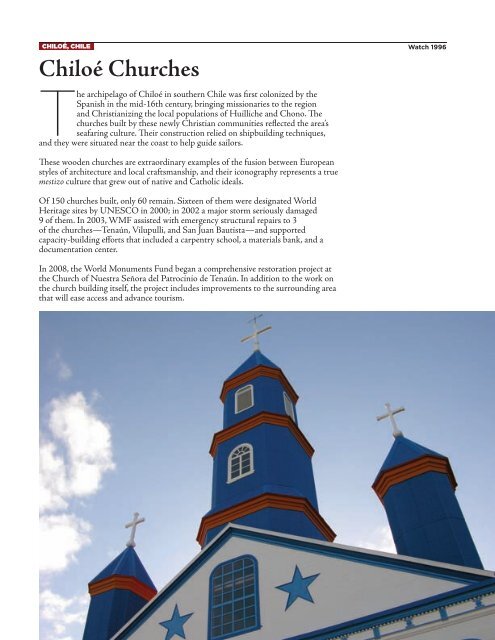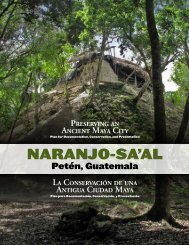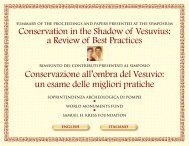2008 Annual Report - World Monuments Fund
2008 Annual Report - World Monuments Fund
2008 Annual Report - World Monuments Fund
You also want an ePaper? Increase the reach of your titles
YUMPU automatically turns print PDFs into web optimized ePapers that Google loves.
ChiloÉ, ChilE<br />
Chiloé Churches<br />
The archipelago of Chiloé in southern Chile was first colonized by the<br />
Spanish in the mid-16th century, bringing missionaries to the region<br />
and Christianizing the local populations of Huilliche and Chono. The<br />
churches built by these newly Christian communities reflected the area’s<br />
seafaring culture. Their construction relied on shipbuilding techniques,<br />
and they were situated near the coast to help guide sailors.<br />
These wooden churches are extraordinary examples of the fusion between European<br />
styles of architecture and local craftsmanship, and their iconography represents a true<br />
mestizo culture that grew out of native and Catholic ideals.<br />
Of 150 churches built, only 60 remain. Sixteen of them were designated <strong>World</strong><br />
Heritage sites by UNESCO in 2000; in 2002 a major storm seriously damaged<br />
9 of them. In 2003, WMF assisted with emergency structural repairs to 3<br />
of the churches—Tenaún, Vilupulli, and San Juan Bautista—and supported<br />
capacity-building efforts that included a carpentry school, a materials bank, and a<br />
documentation center.<br />
In <strong>2008</strong>, the <strong>World</strong> <strong>Monuments</strong> <strong>Fund</strong> began a comprehensive restoration project at<br />
the Church of Nuestra Señora del Patrocinio de Tenaún. In addition to the work on<br />
the church building itself, the project includes improvements to the surrounding area<br />
that will ease access and advance tourism.<br />
Watch 1996<br />
17
















